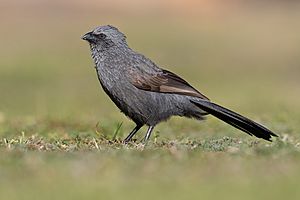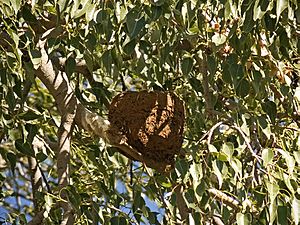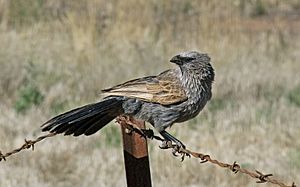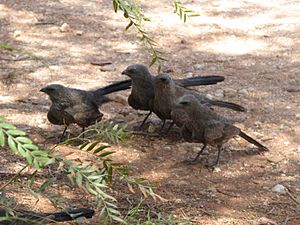Apostlebird facts for kids
Quick facts for kids Apostlebird |
|
|---|---|
 |
|
| Conservation status | |
| Scientific classification | |
| Genus: |
Struthidea
|
| Species: |
cinerea
|
The apostlebird (Struthidea cinerea) is a quick, grey or black bird. It is about 33 cm (13 in) long. You might also hear it called the grey jumper, lousy jack, or cwa bird. These birds live in Australia and like to roam through woodlands. They mostly eat insects and seeds found on the ground.
Apostlebirds often travel in groups of about 12 birds. This is why they were named after the Biblical apostles, who were the twelve main followers of Jesus Christ.
Contents
What is an Apostlebird?
The apostlebird was first described by a bird expert named John Gould in 1837. Its scientific name, cinerea, means "grey" in Latin. This bird belongs to a special family called the mud-nest builders, or Corcoracidae.
This family includes only two living species. The other one is the white-winged chough. Even though they look different, apostlebirds and white-winged choughs act in many similar ways. The mud-nest builder family is part of a larger group of birds. This group includes well-known birds like crows, ravens, and birds of paradise.
Apostlebirds are very social. They live in family groups that can have between 6 and 20 birds. Sometimes, these groups join together to form even bigger flocks of over 40 birds when they are looking for food. Because they are so social and make loud, grating calls, they have many nicknames. People sometimes call them lousy jacks because they can get many lice. Other names include happy jacks and happy families. Grey jumper is another common name for them.
What Does an Apostlebird Look Like?
An apostlebird is about 33 cm (13 in) long. It is mostly dark grey. Its long black tail can look greenish in the sunlight. The feathers on its head, neck, and chest are a lighter grey-white. Its wings are brownish. Apostlebirds have black legs and a black beak. Their eyes can be brown or white.
Where Do Apostlebirds Live?
Apostlebirds live across inland eastern Australia. You can find them from northern Victoria and eastern South Australia, up through New South Wales and central-western Queensland. They also live in the Gulf Country. There is even a separate group of them in the Northern Territory.
They prefer dry, open woodlands. They especially like areas with Callitris trees in New South Wales and Casuarina trees in Queensland. In the Northern Territory, they like Lancewood-Bulwaddi areas.
How Do Apostlebirds Raise Their Young?

Apostlebirds are cooperative breeders. This means that many birds in a group help raise the young. Usually, each group has only one breeding pair. The other birds are often their offspring, relatives, or other adult birds that act as helpers.
Most birds in the group help build the nest. They also share in keeping the eggs warm. And they work together to protect the nest from dangers. Once the eggs hatch, all group members help feed the chicks. They also keep the nest clean.
Apostlebirds have a "fission-fusion" society. This means their groups change size. In winter, birds gather in larger flocks. But when it's time to breed, these big winter groups split into smaller breeding groups. This happens because breeding groups merge in winter and then separate again for the summer breeding season. Breeding groups use small areas around their nest. In winter, they use larger areas and interact freely with other groups.
Apostlebirds breed from August to December. Their nest is a deep, cup-shaped structure. They build it from grasses held together with mud or sometimes animal waste. They usually place the nest in a tree fork, up to seven or eight metres above the ground. The female lays three to five eggs. They are pale blue-white with brown and lavender spots. Each egg is about 22 mm by 29 mm and is shaped like a tapered oval.
Are Apostlebirds Endangered?
Apostlebirds are not listed as threatened under Australia's main environmental law, the Environment Protection and Biodiversity Conservation Act 1999. However, their conservation status can be different in various Australian states. For example, in Victoria, the apostlebird is listed as threatened on the Flora and Fauna Guarantee Act (1988).
See also
 In Spanish: Corvino apóstol para niños
In Spanish: Corvino apóstol para niños




